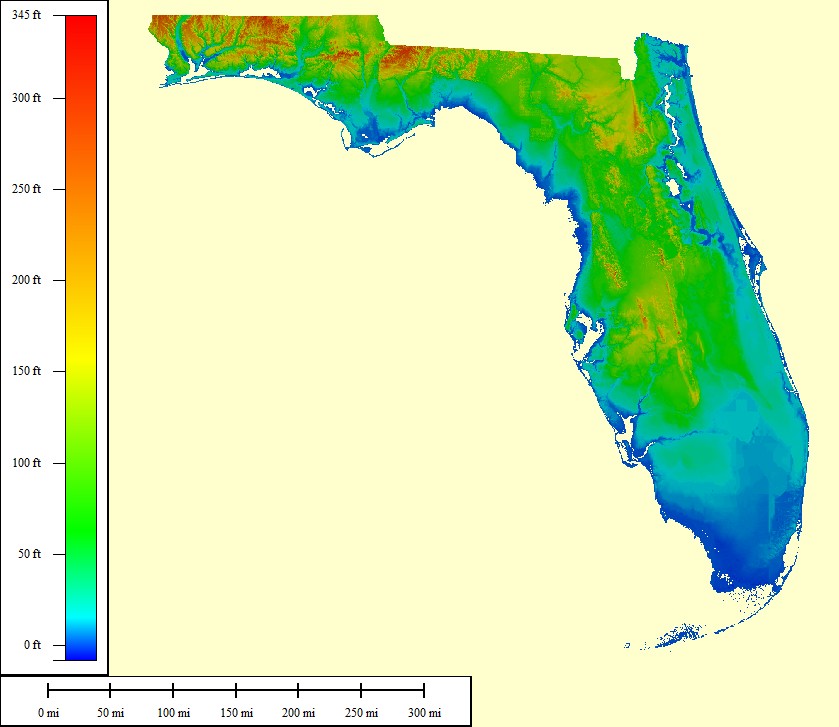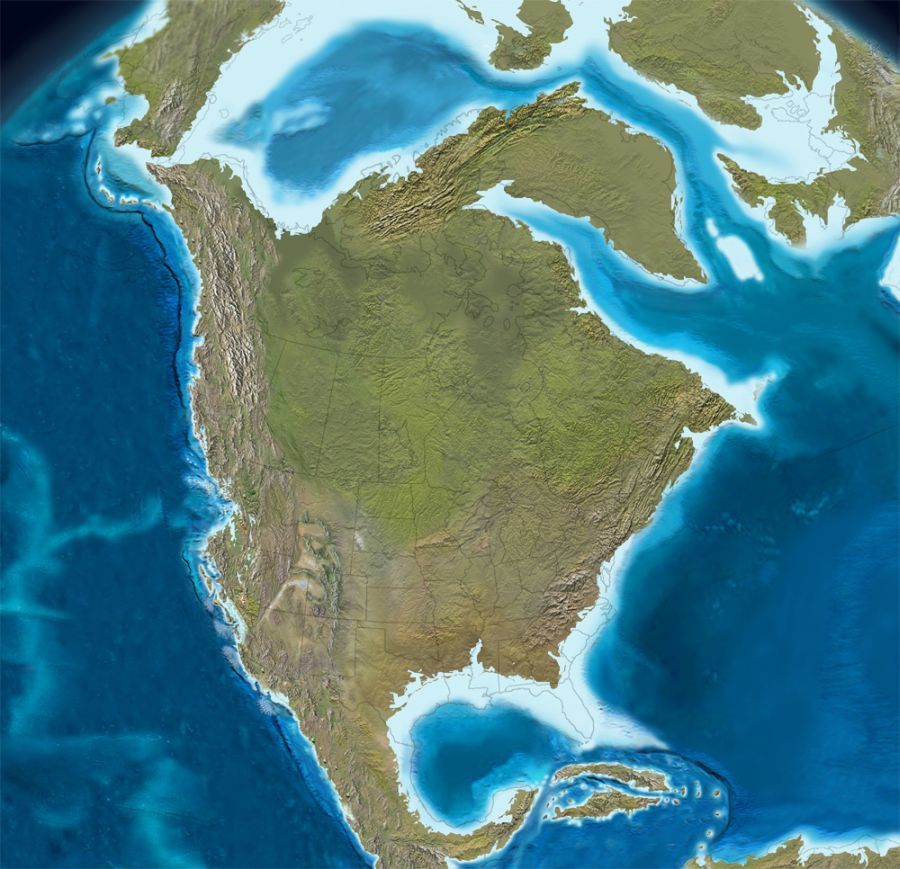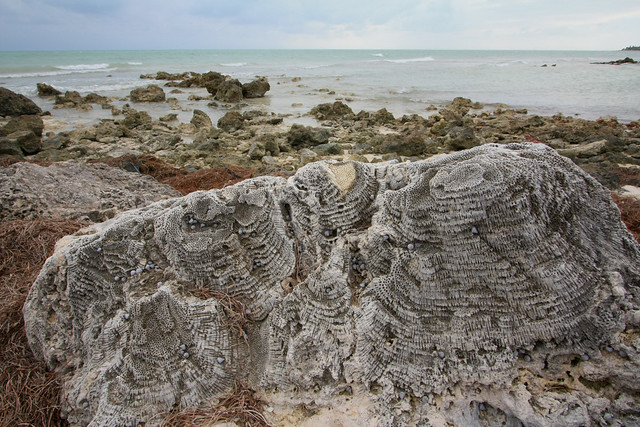jamesp
Cave Dweller 
Member since October 2012
Posts: 36,607
|
Post by jamesp on Oct 5, 2013 5:26:49 GMT -5
Amazing. The yellow is where it is. The reds is to high and the greens are too deep. The broad plateaus in the northern section and central section of the peninsula. The panhandle (to the left) was probably to steep and had too much wave action. So yellow at 160 to orange at 200 in the broad flat areas. Zero- 40 feet is the best depth for coral. Shallow probably warmer and better for light penetration. Those large areas are covered with sand and to find coral there must be an excavation or a river exposing it. The northern area extends into Georgia about 20 miles and has a wide variety of color and a high percentage of glass like silicifications in large pieces. Death plate and fossilized algae layers also very well silicified. The southern plateau is a very different silicification in terms of color and often an orientation of fracture as if layered a bit, but often totally homogenous. The higher areas in the yellow zone are particularly productive. Probably closest to the surface and getting the most intense sun creating very large corals.  |
|
|
|
Post by rockpickerforever on Oct 5, 2013 7:35:20 GMT -5
James, looks like a lot of science involved with finding just thr right area to harvest. I think you've got it figured out.
|
|
jamesp
Cave Dweller 
Member since October 2012
Posts: 36,607
|
Post by jamesp on Oct 5, 2013 7:52:30 GMT -5
Morning Jean. Yes, i can find excavations and creeks in that area and park and probe around for solids. The creek/road crossings are easiest.
|
|
|
|
Post by rockpickerforever on Oct 5, 2013 9:01:04 GMT -5
Good morning, James.
|
|
panamark
fully equipped rock polisher
  
Member since September 2012
Posts: 1,343
|
Post by panamark on Oct 5, 2013 9:08:18 GMT -5
Well James it would help if you put the roads on the map so we can find these places, LOL Map of North America about 50 million years ago shows higher ocean levels and Florida was underwater shallow water.  |
|
jamesp
Cave Dweller 
Member since October 2012
Posts: 36,607
|
Post by jamesp on Oct 5, 2013 9:32:06 GMT -5
You see that little brown point leaving south Georgia and going into Florida? That's my main collection area. Exactly that area. To a tee. And that section was under water and the water came up to the 'fall line' during this or another age and covered the bottom half of Georgia. Like there were different ages and different beaches. There is the southern patch too, near Tampa. Then,...there was the ice age. And Florida got about as big as the white area as the water got bound up in ice, as you see on your map. It was 3 times larger. That is when the indians camped on the ocean floor. That's why they find indian camps way out in the ocean. That is why the bottoms of my coral rivers are peppered with indian camps. The rivers were mere springs and severed as perfect camps. That is why the coral rivers are peppered with ice age artifacts(paleo age). Cool stuff. Thanks for adding. The fall line defined: www.georgiaencyclopedia.org/articles/geography-environment/fall-line |
|
Deleted
Deleted Member
Member since January 1970
Posts: 0
|
Post by Deleted on Oct 5, 2013 11:28:43 GMT -5
Awesome lesson here but I am confused on a couple of things. First: Is Florida an area of uplift or sediment from rivers? Or something else entirely?
Second: It sounds like you are saying there is no coral in the panhandle but it is showing a lot of yellow. I read back over it and maybe I do understand. I think, thank, thunk. Ok, I do understand but I am leaving this here anyway to waste your time. The first is still an unknown.
Jim
|
|
jamesp
Cave Dweller 
Member since October 2012
Posts: 36,607
|
Post by jamesp on Oct 5, 2013 21:12:43 GMT -5
I am not sure why Florida is there Jim. Some say the gulf of Mexico is a meteor hole and Florida is part of the rim. That is a puzzle to me.
The panhandle has a lot of yellow but notice they are slopes. Where it goes red orange yellow green is a slope. Coral does not do well on slopes, it prefers large flats with no wave action.
If you drive across the panhandle you will notice how hilly it is. But the peninsula is very flat. And this is theory. But i know many sections of Florida and the geology. And those 2 flat patches have a lot of
silicified coral over a huge area. But it is under sand that probably averages 20-30 feet deep. I am sure there was coral all over Florida. The crop that grew during that time period just happened to silicify.
The everglades are sitting on fossilized coral too. From another age i believe. But none of it silicified.
Maybe i confused you worst ha. Hope that helps.
|
|
quartz
Cave Dweller  breakin' rocks in the hot sun
breakin' rocks in the hot sun
Member since February 2010
Posts: 3,359
|
Post by quartz on Oct 5, 2013 23:21:34 GMT -5
All this is some interesting discussion, and a good learning lesson for me up here in fungus corner. Thanks. Larry
|
|
panamark
fully equipped rock polisher
  
Member since September 2012
Posts: 1,343
|
Post by panamark on Oct 5, 2013 23:37:01 GMT -5
Awesome lesson here but I am confused on a couple of things. First: Is Florida an area of uplift or sediment from rivers? Or something else entirely? Jim, if I am remembering correctly, the Florida peninsula is mostly formed from sediment accumulation due to the ocean currents colliding in that area. Just like in a river, when different currents collide often times they will slow and will drop the sediment they are carrying. Over 100's of millions of years this can added up to 1000's of feet of sediment accumulating into Florida. People who have gone offshore of eastern Florida can tell you the Gulf Stream really rips moving north (average of 5 to 7 knots I believe). The Gulf of Mexico is more of a bathtub speed compared to this, so before the dry peninsula fully formed there was an edge of fast water hitting a body of slower water and the sediment accumulated. I will have to read up more on this, but I believe this is right. |
|
jamesp
Cave Dweller 
Member since October 2012
Posts: 36,607
|
Post by jamesp on Oct 6, 2013 0:08:17 GMT -5
That current theory makes sense. The ocean moves w/powerful currents. There are even loop currents in the gulf that are powerful but the gulf stream is real strong. Florida has a lot of rock. I visited a quarry in central Florida and 15 foot boulders of solid chert were being crushed in to road gravel. The everglades and the keys are solid limestone with usually less the 10 feet of sand on top of it. An old quarry.  And let the water erode the fossil shapes and you see the coral. It's almost all limestone base fossil coral. Huge pieces  |
|
|
|
Post by Donnie's Rocky Treasures on Oct 6, 2013 6:55:42 GMT -5
Yep, that's what it's like here in the Keys. Big chunks like that everywhere, almost impossible to dig any kind of a hole without some kind of equipment to break it up.
|
|
jamesp
Cave Dweller 
Member since October 2012
Posts: 36,607
|
Post by jamesp on Oct 6, 2013 8:54:56 GMT -5
First time to the Keys i went to stay w/my cousin for a month in Key West and i was astounded at the geology Donnie.
The lower section of Florida is just a fossil coral reef. I is solid though. Like soft concrete. I was looking for the building blocks they saw out of that stuff in google images to show it off.
Some of the most interesting coral patterns you will ever see.
I am always posting coral but it is a joke compared to the fossilized sections of the everglades and the keys. Unfortunately it never silicified until you get to Tampa. And that material was heavily
mined by ancient man for tool material for all of southern Florida.
They may have outlawed the extraction of that limestone.
|
|
|
|
Post by Donnie's Rocky Treasures on Oct 6, 2013 9:00:21 GMT -5
All I know is that I would love to extract it out of the yard!
|
|
jamesp
Cave Dweller 
Member since October 2012
Posts: 36,607
|
Post by jamesp on Oct 6, 2013 9:04:04 GMT -5
The Coral Castle in Homestead Florida. Those blocks are sawn out of the coral that makes south Florida.   |
|
jamesp
Cave Dweller 
Member since October 2012
Posts: 36,607
|
Post by jamesp on Oct 6, 2013 9:10:32 GMT -5
All I know is that I would love to extract it out of the yard! Must be like gardening on a concrete slab. No problem. Just hire one of these. The sawing of foundations, septic tanks, ditches is what blew my mind. No worry about caving in.  |
|
Deleted
Deleted Member
Member since January 1970
Posts: 0
|
Post by Deleted on Oct 6, 2013 10:31:48 GMT -5
So I guess there is not going to be a big wave come along and wash Florida away.  Jim |
|
|
|
Post by rockpickerforever on Oct 6, 2013 10:42:46 GMT -5
That looks about the hardness of the clay in my yard, LOL! No problems with gophers, they can't even dig in it.
So, do you have another trip planned, James?
|
|
jamesp
Cave Dweller 
Member since October 2012
Posts: 36,607
|
Post by jamesp on Oct 6, 2013 11:52:35 GMT -5
Worms have SiC teeth. Gophers too.
Jean, there is a storm coming tonite. It is a gulf tropical that died. Never can tell how much rain is coming. They say they die and they often drop more rain than calculated.
Yes,if coast is clear.
|
|
|
|
Post by Donnie's Rocky Treasures on Oct 6, 2013 12:19:19 GMT -5
Yep, James, that's what they're doing now for the new sewer system they have forced everyone to change to, not to mention pay for!!!! Thank you very much all you wacko environmentalists!!!!!!
|
|























